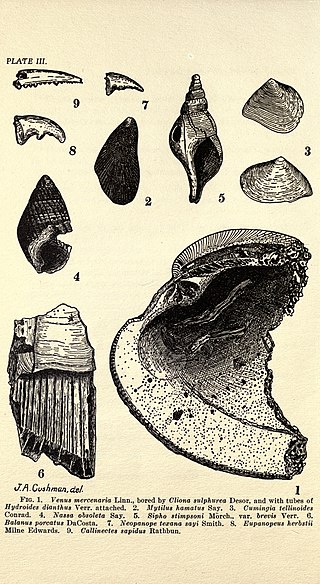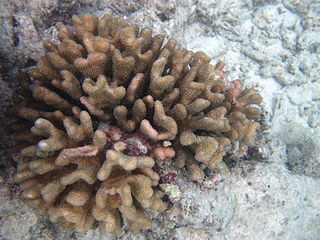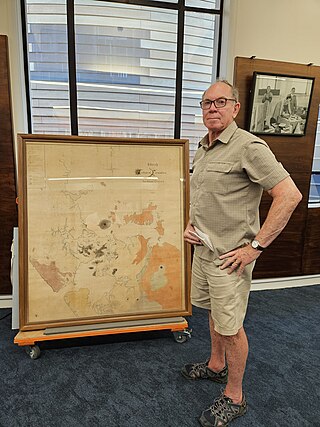Related Research Articles

Xenophyophorea is a clade of foraminiferans. Xenophyophores are multinucleate unicellular organisms found on the ocean floor throughout the world's oceans, at depths of 500 to 10,600 metres. They are a kind of foraminiferan that extract minerals from their surroundings and use them to form an exoskeleton known as a test.

Foraminifera are single-celled organisms, members of a phylum or class of Rhizarian protists characterized by streaming granular ectoplasm for catching food and other uses; and commonly an external shell of diverse forms and materials. Tests of chitin are believed to be the most primitive type. Most foraminifera are marine, the majority of which live on or within the seafloor sediment, while a smaller number float in the water column at various depths, which belong to the suborder Globigerinina. Fewer are known from freshwater or brackish conditions, and some very few (nonaquatic) soil species have been identified through molecular analysis of small subunit ribosomal DNA.

An abyssal plain is an underwater plain on the deep ocean floor, usually found at depths between 3,000 and 6,000 metres. Lying generally between the foot of a continental rise and a mid-ocean ridge, abyssal plains cover more than 50% of the Earth's surface. They are among the flattest, smoothest, and least explored regions on Earth. Abyssal plains are key geologic elements of oceanic basins.

Cesare Emiliani was an Italian-American scientist, geologist, micropaleontologist, and founder of paleoceanography, developing the timescale of marine isotope stages, which despite modifications remains in use today.

Joseph Augustine Cushman was an American micropaleontologist and academic. He specialized in the study of marine protozoans (foraminifera) and became the foremost foraminiferologist of the first half of the twentieth century, developing to a "world-famous system of discovering petroleum deposits". He also was a founding father of Kappa Delta Phi fraternity.

The Kaskapau Formation is a geological formation in North America whose strata date back to the Late Cretaceous.

Naso elegans, the elegant unicornfish, the blonde naso tang, Indian orange-spine unicorn, lipstick surgeonfish, lipstick tang, orangespine unicornfish or smoothheaded unicornfish, is a species of marine ray-finned fish belonging to the family Acanthuridae, the surgeonfishes, unicornfishes and tangs. This species is found in the Indian and western Pacific Oceans.
G. elegans may refer to:
Miliamellus is a genus of Cenozoic benthic foraminifera with tests made of imperforate opaline silica. It is the only genus in the order Silicoloculinida and the family Silicoloculinidae. It is sometimes referred to by the junior synonym Silicoloculina.
The Cassidulinacea is a superfamily of benthic amoeboid foraminifera in the order Rotaliida that has been extant from the Paleocene down to the present. Tests are composed of secreted, optically radial or granular, perforate calcite with chambers biserially coiled at least in the early part, Apertures are usually an interiomarginal slit, but may become terminal and may have secondary features.
Globigerinoides is an extant genus of shallow-water planktonic foraminifera of family Globigerinidae. First appearing in the Oligocene these foraminifera are found in all modern oceans. Species of this genus occupy the euphotic zone, generally at depths between 10-50m, in waters which cover a range of salinities and temperatures. They are a shorter lived species, especially when compared to Globorotalia genus. As a genus Globigerinoides is widely used in various fields of research including biostratigraphy, isotope geochemistry, biogeochemistry, climatology, and oceanography.
C. elegans most commonly refers to the model round worm Caenorhabditis elegans. It may also refer to any of the species below. They are listed, first in taxonomic order and, second, alphabetically.
Conicotheca nigrans is a species of benthic Foraminifera that was first identified from samples collected from the Challenger Deep in the Mariana Trench. C. nigrans has a test or outer shell of agglutinated organic materials and minerals. As a species belonging to a basal clade of foraminifera, the order Allogromiida, C. nigrans may be informative about the evolution of the forams.

Sebastes schlegelii, also known as the Korean rockfish, northern black seaperch, and black rockfish, is a predatory species of marine ray-finned fish belonging to the subfamily Sebastinae, the rockfishes, part of the family Scorpaenidae It is found in the Northwest Pacific Ocean.
Globocassidulina elegans is a species of foraminifera. It is a marine species found in the Japanese and New Zealand Exclusive Economic Zones.
Cibusoides is a genus of benthonic foraminifera.

Cyclammina is a genus of foraminifers in the family Cyclamminidae. Most species are extinct, but there are a few that are extant.

Cuneolinidae is an extinct family of prehistoric foraminifera in the order Loftusiida, in the suborder Ataxophragmiina and superfamily Ataxophragmioidea.

Pocillopora elegans is a species of colonial stony coral in the family Pocilloporidae. It is native to tropical and subtropical parts of the western, central and eastern Pacific Ocean. It is susceptible to bleaching and various coral diseases and the International Union for Conservation of Nature (IUCN) has listed it as a "vulnerable species".

Bruce William Hayward is a New Zealand geologist, marine ecologist, and author. He is known as a leading expert on living and fossil foraminifera.
References
- ↑ Benthonic foraminifera of the Pacific Ocean. CM Saidova, 1975